Matisse started out with a career in law. What illness caused him to start painting?
Articles and Features
Henri Matisse: the Creative person Who Revolutionized Colour
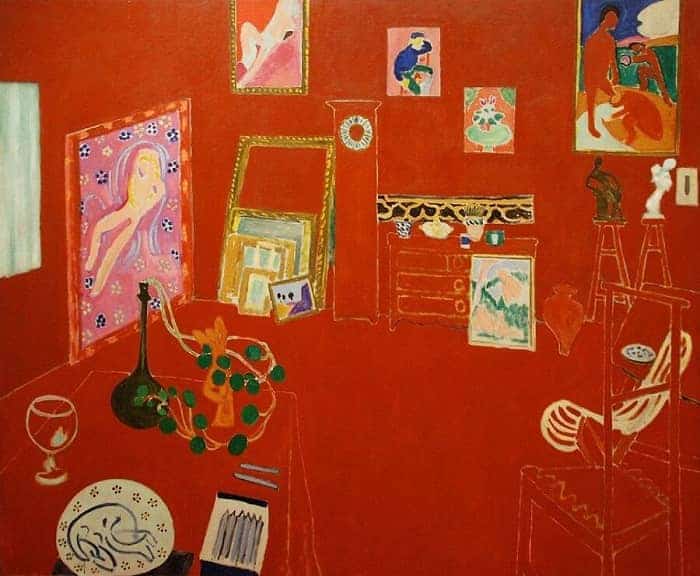
By Charlotte Lydia Stace
French artist Henri Matisse (1869 – 1954) was best known for his use of color and his originality. Although recognized first and foremost for his piece of work equally a painter, he besides worked as a printmaker and sculptor. One of the leaders of Fauvism, he is regarded as one of the almost revolutionary visual artists of the twentieth century. His work has been highly influential in the field of modern art and has continued to inspire generations long after his death.
Read on to find out more almost Henri Matisse's art, life, and legacy.
Biography of Henri Matisse
Permit's outset by answering the question, 'Who was Henri Matisse?' Not only was he 1 of France's most renowned artists with a career spanning six decades, but he was likewise the leader of the Fauvist movement. He devoted much of his career to the experimentation of color and imbued his work with singled-out Mediterranean vigor. So, where did information technology all get-go? Permit'south explore.
Early on life
Henri Matise was born in 1869 in the small-scale industrial boondocks of Bohain-en-Vermandois in northern France. He worked as a legal clerk and afterwards studied for a police degree in Paris between 1887 to 1889 and did non show interest in art until he was 20 years old when, dorsum to his hometown to have up a position in a law office, he began taking drawing classes. Recovering from a short affliction, he started devoting much more fourth dimension and attention to creating art. From this moment on, his talent emerged he returned to Paris to pursue formal creative training to further develop his skills.
Training and success
Whilst attending the Académie Julian and the École des Beaux-Arts, Matisse learned the traditional "academic manner" of creating art. However, he was likewise exposed to the recent Post-Impressionist piece of work of artists similar Paul Cézanne and Vincent van Gogh. He began experimenting with new methods and approaches to producing art and exhibited his work at various galleries around Paris.
After attracting much attention for his advanced approach to creating art, he traveled to the s of France and began creating works that expressed lite in new ways. For instance, his works Luxe, calme et volupté (1904-05) and Open Window and Adult female with a Lid (1905) are examples of his exploration of light and color. He also exhibited these works, which became a huge success. Art critics began referring to artists that played with light and color similar Matisse as ìFauves significant "wild beasts" and their way, often associated with Expressionism past reason of its employ of bold colors and spontaneous brushwork, became known equally 'Fauvism'. Matisse traveled to Italy, Germany, Kingdom of spain, and Morocco for inspiration, looking for new ways to play with vivid colors and light.
Throughout his career he was well-recognized and art collectors of the quotient of Gertrude Stein bought much of his piece of work. He continued to travel, and somewhen moved to Squeamish with his family where he lived and worked until his death. He continued to work with color and even experimented with elements of Cubism, which he picked up from his close friend Pablo Picasso.
Later years and death
Henri Matisse the artist became a well-known and historic figure, both within France and the residuum of the world. His contribution to Fauvism earned him much recognition and success throughout his career and many high-profile commissions in his later years. After beingness diagnosed with intestinal cancer in 1941, he was left oftentimes bedbound and then worked from his domicile for the remaining years of his life. He died in 1954, at the historic period of 84, in Nice and was buried nearby.
Henri Matisse's Famous Paintings
Henri Matisse's paintings have inspired artists for generations. His work is the epitome of Fauvism and was highly influential in advanced circles in the early on to mid 20th century. Hither are some of his most famous pieces.
Joy of Life (1905)
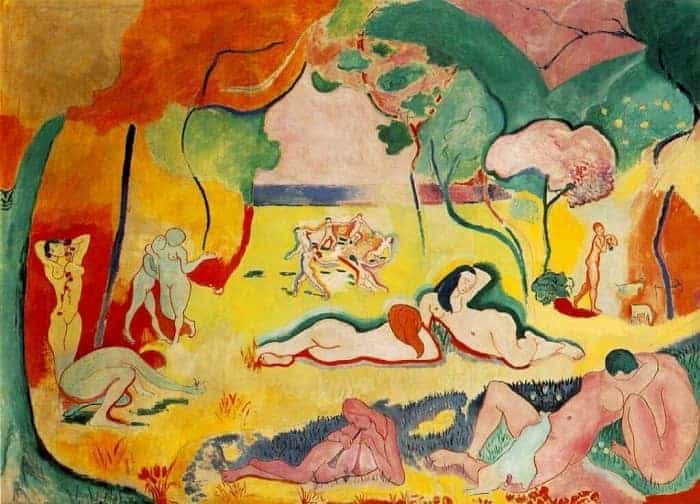
Henri Matisse's Fauvist approach is credible in Joy of Life (1905). Depicting an Arcadian landscape filled with colored forests, meadows, bounding main, and sky and populated past nude figures, the artwork is emblematic of how Mattisse used color to express emotions and his views of nature. Whilst living in Paris, the artist spent many summers in the south of France sketching landscapes and developing the ideas into larger compositions upon his return.
Trip the light fantastic toe (1910)
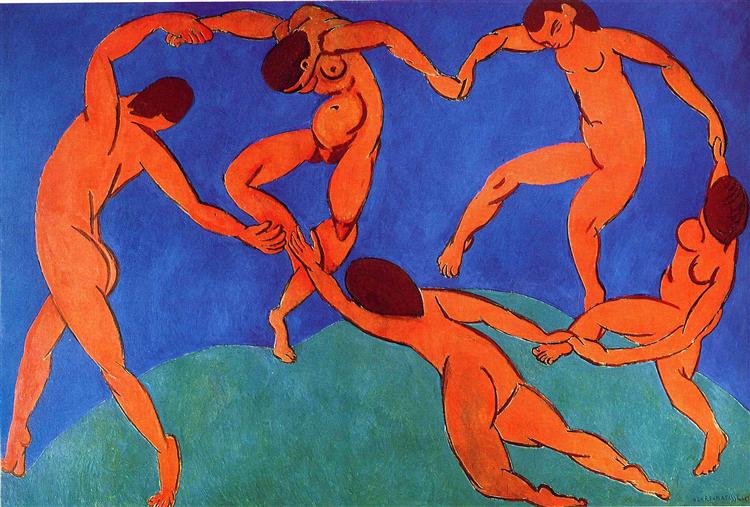
A milestone in the evolution of modernistic painting, Dance (1910) was made at the request of Russian man of affairs and fine art collector Sergei Shchukin, who left this large decorative panel to the Hermitage Museum in Saint petersburg, Russian federation. Matisse'due south figures are drawn loosely in vibrant colors, with almost no interior definition, giving them the impression of light-hearted, joyous entities dancing across the canvas. By reason of its rhythmical succession of dancing nudes, the painting has often been compared to Igor Stravinsky'due south musical piece of work The Rite of Leap.
Goldfish (1912)
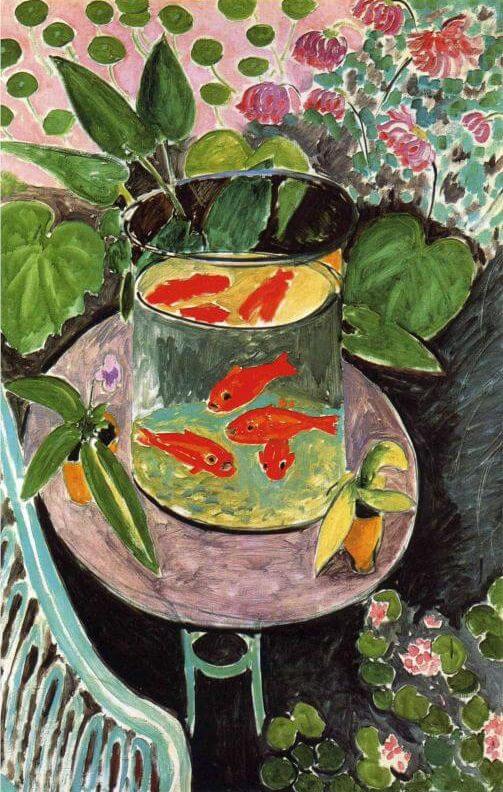
From around 1912, goldfish became a recurring subject field in Henri Matisse's artwork. The fish immediately attract our attending due to their bright color. The orange contrasts with the pinks and greens that surround the fishbowl and the background. Fauvists favored this contrasting coloring technique equally it draws the attention of the viewer to what they wanted to express. For the creative person, goldfish represented peace and tranquillity, something which he institute when traveling across Europe and North Africa.
Jazz (1947)
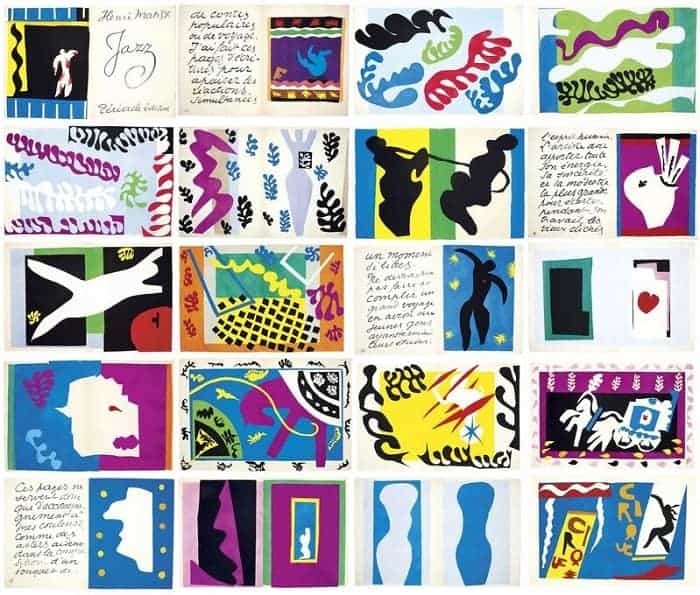
Aside from his contributions to painting and sculpture, Matisse produced several artists' books. He fabricated the majority of these after battling intestinal cancer that left him restricted to the confines of his domicile. The in a higher place epitome shows the twenty cut-out prints he created to illustrate his groundbreaking book Jazz (1947), whose name relates to the experimental and improvisational nature of jazz music. The volume's ascendant themes center around the circus and theater.
In particular, i prototype that stands out is Icarus (1947). Here, the mythological figure is depicted in a simplified form. The figure appears to exist floating against a blueish dark heaven. These flat, abstracted forms and large areas of pure color represented a shift for the artist'south subsequently work with color, prints, and shapes.
Snail (1953)
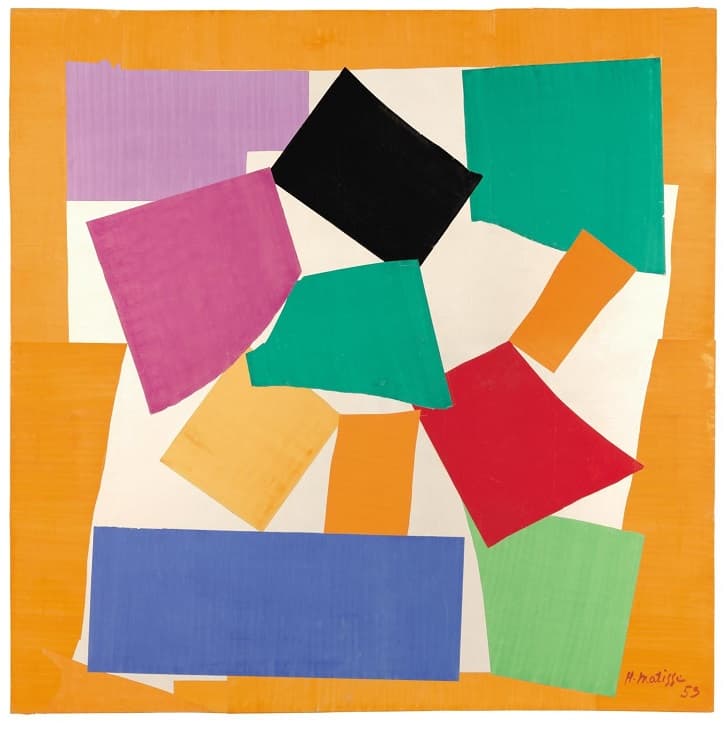
During his time recovering from cancer, Henri Matisse began experimenting with collage works, known as 'gouaches découpées'. He made these pieces by using cut-outs from paper that had been painted with gouache – a water-soluble paint that, dissimilar watercolor, is opaque. The cutting-out shapes were stuck down onto a background by 1 of his administration, post-obit his teaching. In Snail (1953), he used colored shapes in the center of the work to represent the spiral design of a snail'southward shell. The vibrant colors repeat Matisse's delivery to Fauvism.
Legacy of Henri Matisse
Although only a selection of Henri Matisse's artworks is shown hither, by the end of his career the artist had produced countless pieces, from paintings to sculptures. He is remembered equally one of the greatest painters of the 20th century, both in France and too around the world, and is a major effigy of contemporary art history.
Relevant sources
Continue reading on the Artland Magazine
Learn about Henri Matisse's Chapelle du Rosaire in 'From Matisse to Rothko: Artist-Designed Chapels. A Religious Experience'
Observe how Odalisque in Red Trousers past Matisse was stolen and switched with a fake with no one noticing in 'The Fine art of Forgery – Art Forgers Who Duped The World'
Go on reading on other websites
How to paint happiness: a masterclass from Matisse
Wondering where to start?
Source: https://magazine.artland.com/henri-matisse/


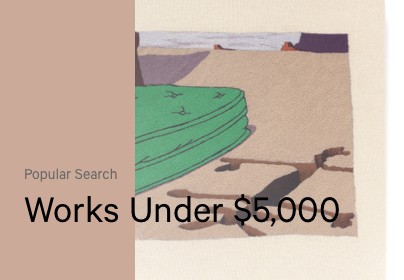
0 Response to "Matisse started out with a career in law. What illness caused him to start painting?"
Post a Comment